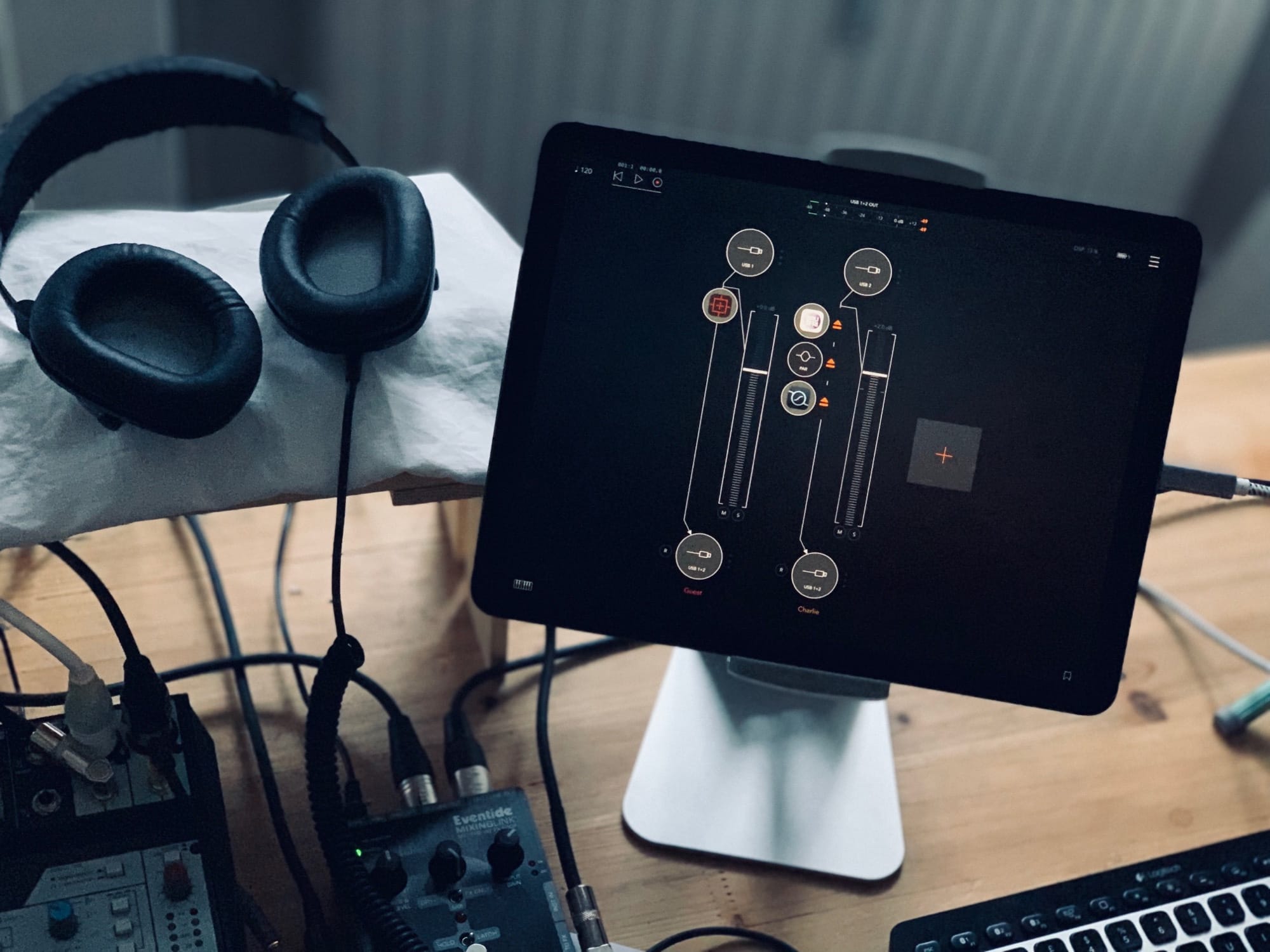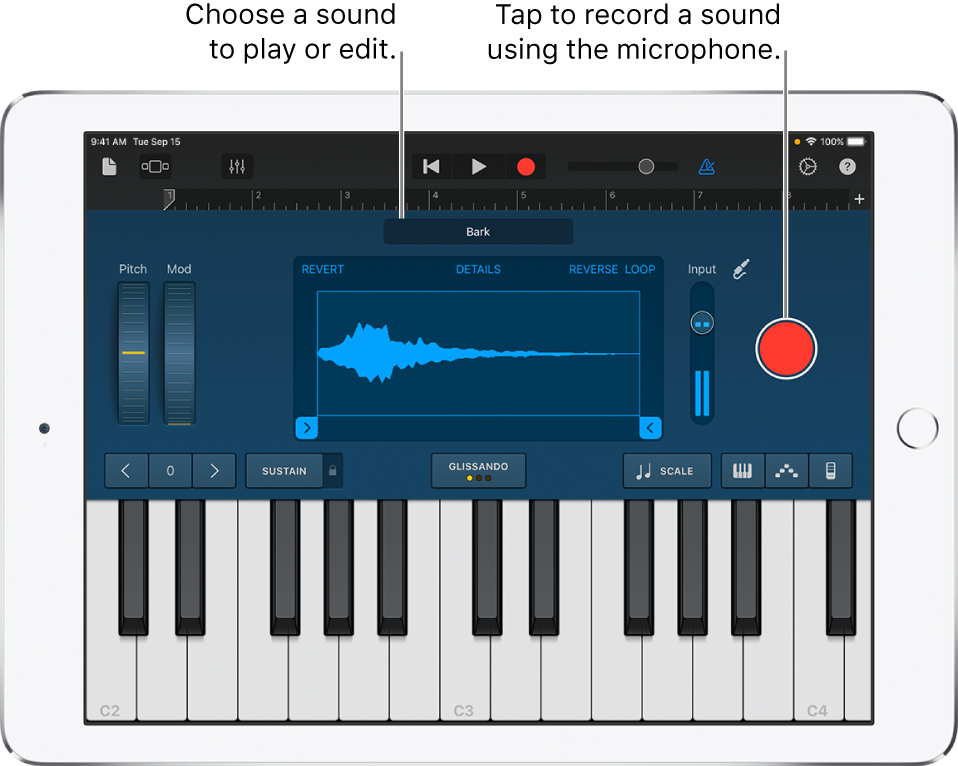If you’ve spent anytime at all on YouTube watching videos of guitarists you know that they range in quality from quick and dirty iPhone videos to more elaborate multi-screen, multi-track presentations.
Until this week and being quarantined and all with the Coronavirus pandemic, I had never really given much thought to posting my own videos or how one might even go about doing so.
Over the past few days, I’ve hit on a pretty good middle-ground between the quick and dirty iPhone video and the more elaborate, high-production quality videos and figured I’d share how I do it.
- It’s also perfectly possible to use GarageBand’s microphone option to record an acoustic instrument, such as a violin or a tuba, but the quality will never be great, because you’re relying on the.
- Singers can sing along to tracks created in GarageBand using the iPad or iPhone’s built-in microphone. For better results, you’ll probably want to plug a microphone into the dock or headset.
Here’s an example of a video I recently recorded of Bob Dylan’s Don’t Think Twice, It’s Alright using the setup detailed below.
I’m going to break this HowTo into 3 sections:

I'm trying to record something on my iPad in GarageBand with an external mic. I can see that the mic is powered on, but I can't tell if my iPad is automatically using my external mic or if it defaults to the built-in mic. Hoping someone here might know of a way to check what device is being used for recording?
- Part 1, recording guitar and vocal into GarageBand on iPad using 2 external microphones
- Part 2, recording the video component
- Part 3, synchronizing the audio and video component and publishing the final product.

Part 1
Recording guitar and vocal into GarageBand on iPad using 2 external microphones

I record my audio using Garageband. By design I don’t do a lot of tweaking to the default settings. I use the preset “lead vocal” setting for the vocals and the default “nice room” setting for the guitar. I don’t fiddle with the EQ.
Here are some details from Apple on using the “Audio Recorder” function of GarageBand on iPad. Some very useful stuff here and worth looking over.
Recording into an iPad Pro with external microphones requires some kind of Audio Interface to convert the XLR or 1/4″ inputs of your microphones into USB for the iPad.
I have an older Zoom H4n Pro that does double duty as field recorder and an audio interface (here’s how to set it up). I got lucky, I had no idea it had the audio interface feature when I bought it, but it does.
So I didn’t need to buy an interface. If you need one, for under $200, the Focusrite Scarlett 2i2 is referenced on a lot of websites/videos as being a good safe bet.
Once you have your microphones and XLR cables, here’s a diagram detailing how I get them into the iPad.
Once you have all the hardware hooked up, you can just record into GarageBand.
You can, of course, go down some really deep rabbit holes of which microphones to use, mic placement, eq, etc. Feel free. I’m using a Shure SM-58 and a Sennheiser 609 that I usually use for mic’ing up my amplifier but seems to work just fine for vocals. Very easy to start chasing marginal gains with this kind of stuff. My advice is get it good enough and start recording.
There are a couple of minor settings changes you need to make in GarageBand to do simultaneous multitrack recordings. This guy has a fantastic video. If you’re not super-familiar with GarageBand and don’t want to through your iPad out the window trying to sort out multitrack recording on your own, I highly encourage you to sit through this guy’s tutorial.
Ok, so that’s the audio part! I’ll write up the video and synchronization stuff as soon as I can.
Owning an iPad may solve many of your problems, but getting a top-notch recording experience is not one of them. For this particular reason, people prefer external microphones that can record any sound, sometimes even multiple sound sources. But what are these devices and which one to choose? To solve this problem, we are going to talk about everything you may need to know for how to connect external mic to iPad!
You can also read: Cool Things to Do with AirPods
What is an Audio Interface?
The market is filled with numerous external microphones that you can purchase. But the external microphone is not your only concern. For the connection, you need several other devices so you can record anything.


The connection depends on what device you use for adding an external microphone with your iPad. An audio interface is the most popular when it comes to recording.
Well, an audio interface takes care of every recording of you. The main function is to convert the captured audio signal into a digital signal. This is done by an A/D converter which transforms the sound into signals that can be expressed via 0 and 1. Then it is stored or it can be even edited by you.
When you need to hear the sound, this digital signal converts once again. This time the process is reversed and it is called D/A conversion. These interfaces can not only add external microphones but can also add guitar cables. You can hear the recordings anytime via your earphones or speakers.
Now, audio interfaces can vary depending on your purpose. There are multiple types of audio interfaces. Some of these are perfect for everyday use such as podcasts, vlogging. However, if you need to record audio tracks that need to have clear smooth audio then you need interfaces that support professional recording.
Which Type of Audio Interface Should I Choose?
First, you need to realize how many audio sources you need to record. For example, if you are only working with a single sound source or one particular instrument, you can choose Focusrite Scarlett Studio 3rd Generation.
The Scarlett 3rd Gen Interface also offers audio interfaces that are a little bit advanced. For example, Cusrite Scarlett 2i2 is for capturing multiple sources. This particular audio interface also features air mode that gives the best quality audio.
Is There Any Other Option Available?
Another option that you can choose for connecting an external microphone is field recorders. Field recorders can be a substitute for an audio interface. Moreover, field recorders offer an added advantage where you do not need any power supply.
So if you are outdoors, for example, if you’re camping or hiking, you can choose field recorders. That’s why they are named field recorders so you can capture even the sound of nature, without any problem.
However, even though people need additional AC power with audio interfaces, audio interfaces are more popular and preferred by people.
What Do I Need for Connecting an External Mic to iPad?
- Audio interface or field recorder, depending on your usage. We suggest an audio interface
- Microphone. Any external microphone will work. However, the quality depends solely on you.
- The cables depend on your port. Depending on your port you will either need USB-C to USB-C cable or Lightning to USB 3 Camera Adapter.
- Powered USB Hub for power so they can function. You also need headphones so you can listen to your recording and identify any errors if they occur.
How Do I Connect My External Microphone?
For an iPad that Features USB-C Port
The adapter will depend on your audio interface. If the audio interface can work with USB-C cable then buy a USB-C to USB-C cable.
However, for audio interfaces that do no support such configuration, you will require a USB to USB-C adapter. Then, add the audio interface with your iPad via your adapter or cable.
For an iPad that Features Lightning Port
You will require a lightning to USB-3 camera adapter for connecting an external mic to your iPad. Add the audio interface with your iPad via your adapter or cable.
Remaining Connection
After this connection, you need to add the external mic with your audio interface. Your connection has been complete! Now you can use this to record almost anything you want. Add a headset so that you can hear your recording after.
This is actually an amazing way to ensure you get to record anything through your iPad. Once you realize the process, you can purchase any type of external microphones for high-quality audio.
You can also use your iPad to stream anything anywhere, also as we mentioned before.
You need to use a Powered USB Hub for supplying power to your audio interface. The device can send warning messages which indicate these additional connections require a power supply.
For this purpose, a Powered USB Hub needs to be added to any power source. Then add the Powered USB Hub with your iPad and connect it with your audio interface. You can use the Lightning to USB 3 Camera Adapter for this purpose.
Though you may connect the external microphone correctly, sometimes they may not function. So you need to do an error check. For this purpose, check if the microphone is muted or if the cables are loosely plugged. Moreover, check if the powered USB Hub is functional too.
Using External Mic With Garageband Ipad Pro
Sometimes due to this, the external microphone does not record. There should also be a recording indication on your iPad which you can check.
However, if none of these work, check your settings. If you are recording for some app then check if your settings allow microphone access to these apps known as third-party apps.
Using External Mic With Garageband Ipad Charger
Final Thoughts
Using External Mic With Garageband Ipad Air
Hopefully, we have been able to answer every question of yours. So, the audio interfaces also change depending on your need and the cables vary depending on your port. So the first step of connecting your external microphone is understanding what you need. Do not purchase something that cannot be supported by your iPad. Finally, follow our simple instructions step-by-step for a hassle free connection. Best of luck!